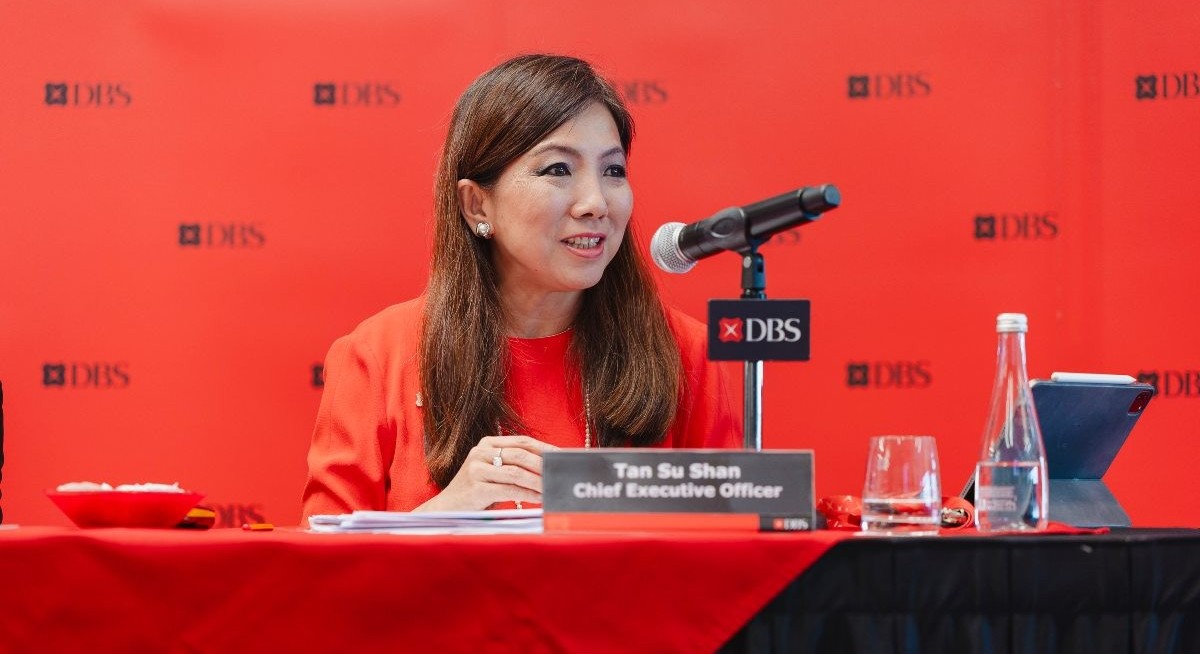That appears to have materialised; although group NIM fell 7 basis points (bps) q-o-q and 9 bps y-o-y to 2.05% in 2QFY2025, DBS posted 2% higher NII y-o-y of $3.65 billion. DBS chief financial officer Chng Sok Hui tells The Edge Singapore that June’s exit NIM was 1.98%.
This is set to continue; Tan expects FY2025 NII to come in “slightly above FY2024 levels” with “proactive hedging and strong deposit growth”.
Tan says: “We focus on NII; don’t focus on NIM, because NIM will go down with the markets, but NII can go up with volumes. That’s how you mitigate that and also how you hedge your NII risk nimbly.”
Instead of giving a single NIM sensitivity figure, Tan divided the figure between Singapore dollars (SGD) and US dollars (USD), which makes up the bulk of the bank’s non-SGD book. The bank has $90 billion in net floating assets for SGD, which means the bank will lose about $9 million for every bp decline. Meanwhile, the bank has roughly $40 billion in net floating USD liabilities, which means every 1 bp drop in rates will lead to a $4 million rise in the bank’s total income.
See also: What would an imaginary merger of DBS and Standard Chartered look like?
Out of a loan book of $439.1 billion, SGD loans account for $168.1 billion, followed by USD loans of $108.1 billion. The USD deposit base of $220 billion is the bank’s second largest after SGD. Of this, more than $70 billion is in current and saving accounts.
“In the past, people focused on pass-through rates, because that’s what we were used to. The Fed cuts rates; rates in Asia go down,” Tan says. “I think that relationship has broken down, so no point trying to predict what the pass-through rates are going to be for different currencies. Instead, focus on what part of your balance sheet is floating.”
DBS’s house view is for two Fed rate cuts in the remainder of the year.
See also: SGX denies it is in talks to buy Cboe Australia
Loans rose 4% y-o-y in constant-currency terms to $433 billion in 2QFY2025, led by non-trade corporate loans from broad-based growth across industries, according to DBS.
The bank continued to see “very strong” deposit growth in July, says Tan, and non-trade loans are “still solid”. These are coming from what DBS calls the “telecommunications, media and technology” sector, which includes data centres; along with real estate, thanks to multiple Government Land Sales sites in Singapore, according to Tan.
She says Asian investors have also been “looking at opportunities” in private assets and real estate in Tokyo and London, along with logistics and transportation. These have been contributing to loan growth.
In Hong Kong, DBS reported 5% lower loan growth y-o-y in 1HFY2025, but says risks are limited in its commercial real estate book despite the sector’s recent slump.
2QFY2025 was a “tough quarter”, says Tan, with “factors that would incur a perfect storm” — including Liberation Day in April, Mideast tensions and a “plunge” in the Singapore Overnight Rate Average (Sora) and Hong Kong Interbank Offered Rate (Hibor).
Still, DBS’s net profit for the quarter rose 1% y-o-y to $2.82 billion, 1% above consensus; while 1HFY2025 net profit was slightly lower y-o-y at $5.72 billion, compared to $5.76 billion this time last year.
Meanwhile, DBS’s 1HFY2025 commercial book net fee income rose 17% y-o-y to a record $2.44 billion, led by a 30% increase in wealth management fees to $1.37 billion.
To stay ahead of Singapore and the region’s corporate and economic trends, click here for Latest Section
Tan notes that wealth also includes the “middle” and “retail” segments, and Shee Tse Koon, DBS’s group head of consumer banking and wealth management, says momentum has been “very strong” across both the private bank and treasuries businesses.
Asked about hiring more relationship managers (RM) to meet Tan’s goal of increasing volume, Shee says DBS has been “quite proactively growing our RM numbers from last year”. DBS “front-loaded” this in 1H2025, hiring “about 80% of what we wanted to hire”, he adds.
For the first half, consumer banking and wealth management income rose 4% y-o-y to $5.28 billion, underpinned by higher net new money inflows and stronger investment product and bancassurance sales.
DBS’s ordinary dividend of 60 cents per share and a capital return dividend of 15 cents per share for 2QFY2025 bring first-half amounts to $1.20 per share and 30 cents per share, respectively. The ordinary dividend is up from $1.08 per share this time last year.
When asked about the bank’s biggest risks, Tan noted that they were in interest rates and foreign exchange (FX) given that the bank is a “price taker” on both. Yet, she reiterated that there are mitigating factors such as volume growth.
“The good news is, as rates go down, actually, interest rate elasticity also goes down,” she says. “From three to two, there’s a big drop. From two to one, there’s a big drop … There’s more lazy money around the system, and there’s also a lot of inflow into both Hong Kong and Singapore, the two big hubs that we operate in.”
Another risk which the industry is focused on, is cybersecurity.
“We have to be all over this. We have to be sort of on our front foot. We have to guard our customer assets. We’ve got to guard our resiliency and technology and be able to predict [and] prevent anything bad from happening to our customers all the money,” she adds.
Shares of DBS spiked to $49.68 shortly after the market opened and reached an intra-day high of $50. At $50 per share, DBS’s market capitalisation would have been at $142 billion.




